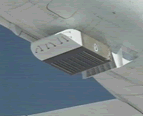Advanced Lightweight Rainfall Radiometer
Advanced Lightweight Rainfall Radiometer Enjoys Successful
Test Flights, Demonstrates Key Benefits for Future Space-based Missions
![]()
A new, lightweight passive microwave radiometer instrument
developed jointly by NASA Goddard Space Flight Center and the University
of Michigan successfully performed six calibration and science validation
flights on board NASA’s DC-8 aircraft. A recent graduate of the NASA Earth
Science Technology Office (ESTO), the Lightweight Rainfall Radiometer (LRR)
produced high-quality science data during one of the 6-hour flights (in
tandem with the JPL PR-2 airborne radar instrument) over a storm system
near Vancouver, WA.
 The
The
X-band LRR, which is suitable for aircraft or space-based platforms, enables
markedly improved measurement of precipitation drop size and distribution
(at 10.7 GHz), as well as rain rate and surface wind speeds, when used
in conjunction with other instruments, such as the PR-2. With a receiver
less than 1/8th the size and using 50% less power than predecessors, the
LRR could lead to a space-borne 25 channel synthetic aperture radiometer
that would not be strictly limited by size and power requirements. The
core technology of the LRR – a synthetically thinned aperture radiometer
(STAR) – demonstrated the feasibility of a one-dimensional geometric interferometer
(no moving parts) for future NASA X-band missions. The lack of a mechanical
scanning apparatus found on traditional radiometers makes the LRR payload
smaller, lighter, and cheaper to launch while also reducing the complexity
and risk of the instrument. The team also conducted an antenna design
study that validated the STAR technology in the critical Ku- and Ka-bands.
Technical contributions came from the Center for Advanced
Microelectronics and Biology Research (CAMBR) at the University of Idaho,
Northrop Grumman Space Technology, the University of Massachusetts, and
NASA Dryden Flight Research Center. The task generated 17 publications
and four graduate-level theses.